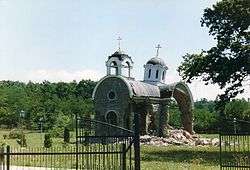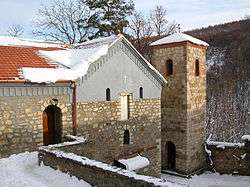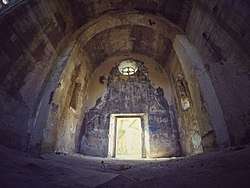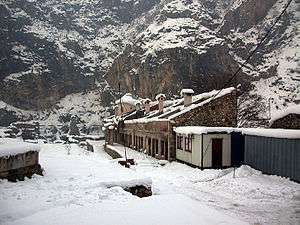Destruction of Serbian heritage in Kosovo


Right: 14th-century icon from UNESCO World Heritage Site Our Lady of Ljeviš in Prizren damaged during 2004 unrest in Kosovo.
Numerous Serbian cultural sites in Kosovo were destroyed during and after the Kosovo War. According to the International Center for Transitional Justice, 155 Serbian Orthodox churches and monasteries were destroyed by Kosovo Albanians between June 1999 and March 2004.[1]
Kosovo War
NATO bombing in March–June 1999 resulted in the damaging of Gračanica, the Patriarchate of Peć complex of four churches, as well as the Visoki Dečani, among the more notable churches.[2]
Aftermath of Kosovo War

According to the cultural historian András Riedlmayer, no Serbian Orthodox churches or monasteries were damaged or destroyed by the Kosovo Liberation Army during the war in Kosovo.[3] Within post-conflict Kosovo Albanian society, calls for retaliation for previous violence done by Serb forces during the war circulated through public culture.[4] The destruction of Serbian architectural heritage was interpreted by Albanians within that postconflict context as architecture becoming a surrogate for forces held responsible committing violence during the war needing to be avenged, in particular the Milošević government and its army.[4] Such fabrication of interpreting architecture as unavenged violence resulted in the mediation of an idea present at the time that destruction of churches and monasteries entailed not only revenge for violence during the 1998—99 war; but also for a chain of real or imagined violent actions going far back as the medieval building of churches upon "crypto-Albanian" religious sites.[4] These discourses of viewing Serbian historical architecture as a surrogates of violence within Kosovo Albanian society had the effect of justifying destruction as an endless process, instead of working toward a politics of justice.[4] Widespread attacks against Serbian religious sites commenced following the conflict and the return of hundreds of thousands of Kosovo Albanian refugees to their homes.[3] Between the arrival of the Kosovo Force (KFOR) in June 1999 and the 2004 unrest in Kosovo, more than 140 holy sites were destroyed.[5]
- Church of St. Elijah, Podujevo, burnt, 1999
- Church of St. George, Rečani, demolished, mid-1999
- Church of St. Paraskeva, interior torched, June 1999
- Church of the Holy Emperor Uroš, burnt, end of June 1999
- Devič Monastery in Srbica, nuns evacuated by Danish soldiers, monastery pillaged and torched, the tomb of St. Joanikije of Devič was desecrated.[6][7]
- Monastery of the Holy Archangels, desecrated with the cemetery and Pine of Tsar Dušan, June–July 1999
- Monastery of the Holy Trinity
- Church of St. John the Baptist, Samodreža, vandalized and burnt, June 1999
- Church of Holy Trinity, Petrič, completely destroyed, June 1999
- Church of the Virgin, Naklo, burnt and destroyed, June 1999
- Church of St. John the Baptist, Pećka Banja, June 1999
- Church of St. Nicholas, Donje Nerodimlje
- Church of Holy Trinity, Velika Reka, 20 June 1999
- Church of the Holy Apostles Peter and Paul, Suva Reka, demolished, 19 July 1999
- Church of the Holy Mother of God, Podgorce
- Church of St. Nicholas, Đurakovac, dynamited, July 1999
- Church of St. Basil of Ostrog, Ljubovo
- Church of the Presentation of the Blessed Virgin Mary in Belo Polje
- The Presentation of the Virgin, Dolac
2004 unrest
In an urgent appeal,[8] issued on 18 March by the extraordinary session of the Expanded Convocation of the Holy Synod of Serbian Orthodox Church (SPC), it was reported that a number of Serbian churches and shrines in Kosovo had been damaged or destroyed by rioters. At least 30 sites were completely destroyed, more or less destroyed, or further destroyed (sites that had been previously destroyed).[5] Apart from the churches and monasteries, tens of support buildings (such as parish buildings, economical buildings and residences), bringing the number close to 100 buildings of the SPC destroyed.[5] All churches and objects of the SPC in Prizren were destroyed.[5] The list includes several UNESCO World Heritage Sites.
| Site(s) | Location | History | Damage |
|---|---|---|---|
| Our Lady of Ljeviš (Bogorodica Ljeviška) | Prizren | 14th c. World Heritage Site | Set on fire from the inside, 12th–14th c. frescos seriously damaged, altar area desecrated, holy table broken[5] |
| Church of the Holy Saviour | Prizren | 14th c. | Set on fire[5] |
| Cathedral church of the Holy Great Martyr George | Prizren | Built in 1856 | Set on fire and mined[5] |
| Church of St. Nicholas (Tutić's Church) | Prizren | 14th c. | Set on fire from the inside[5] |
| Church of St. George (Runović's Church) | Prizren | 16th c. | Set on fire from the inside[5] |
| Church of St. Kyriaki (Crkva sv. Nedelje) | Potkaljaja neighbourhood, Prizren | 14th c. | Burnt[5] |
| Church of St. Panteleimon | Potkaljaja | 14th c. | Burnt[5] |
| Church of Sts. Cosmas and Damian | Potkaljaja | 14th c. | Burnt[5] |
| Church of St. Kyriaki (Crkva sv. Nedelje) | Živinjane near Prizren | - | Mined, completely destroyed by explosion[5] |
| Monastery of the Holy Archangels | Prizren | 14th c. founded by Stefan Dušan | Robbed and burnt, in the presence of German soldiers who failed to protect it[5] |
| Serbian Orthodox Seminary of Prizren and the Bishop's Court | Prizren | Established in 1872 | Set on fire[5] and people attacked on 17 March.[9] |
| Church of St. Elijah | Podujevo | destroyed and desecrated, coffins from the nearby Serbian cemetery were dug up, and bones of the dead were scattered away.[10] |

The violence quickly spread to other parts of Kosovo, with Kosovo Serb communities and religious and cultural symbols attacked by crowds of Albanians. Some of these locations were ostensibly under the protection of KFOR at the time. During the riots and violence, eight Kosovo Serbians were killed. Among damaged property was the targeted cultural and architectural heritage of the Serb people, and as a result 35 churches, including 18 monuments of culture, were demolished, burnt or severely damaged.[11]
Reconstruction
The Reconstruction Implementation Commission (RIC) for Serbian Orthodox religious sites in Kosovo is an EU-funded project to promote the reconstruction of cultural heritage.[12] It has 35 sites under its responsibility.[13]
See also
References
- ↑ Edward Tawil (February 2009). "Property Rights in Kosovo: A Haunting Legacy of a Society in Transition" (PDF). New York: International Center for Transitional Justice. p. 14.
- ↑ Ćurčić 2000, pp. 126–128.
- 1 2 András Riedlmayer. "Introduction in Destruction of Islamic Heritage in the Kosovo War, 1998-1999" (PDF). p. 11.
Remarkably, not a single Serb Orthodox church or monastery in Kosovo was damaged or destroyed by Albanians during the 1998-1999 conflict. Unfortunately that changed after the end of the war, as thousands of Albanian refugees who had been forced out of Kosovo during the war returned to their burned-out home towns and villages. Following the end of hostilities in June 1999, dozens of Serb Orthodox churches and monasteries were damaged in revenge attacks.
- 1 2 3 4 Herscher, Andrew (2010). Violence taking place: The architecture of the Kosovo conflict. Stanford: Stanford University Press. pp. 14-. ISBN 9780804769358. "Part III examines the destruction of architectural surrogates of unavenged violence in postwar Kosovo. After the 1998—99 war, calls for retribution for prior violence inflicted by Serb forces against Kosovar Albanians circulated through Kosovar Albanian public culture. The postconflict destruction of Serbian Orthodox churches and monasteries was narrated as a form of this retribution, with architecture becoming a surrogate for the agencies deemed responsible for the violence to be avenged—initially the Milošević regime and its military forces. The fabrication of architecture as a surrogate for unavenged violence, however, not only mediated an already constituted concept of violence but also ramified on that concept; the destruction of churches and monasteries represented not only revenge for the violence of the 1998—99 war but also a continuous sequence of actual or imagined violent acts stretching back to the medieval construction of churches on crypto-Albanian religious sites. The destruction of architectural surrogates of violence thereby elicited a potentially endless justification for destruction rather than a politics of justice."
- 1 2 3 4 5 6 7 8 9 10 11 12 13 14 15 ERP KiM Info 2004.
- ↑ "CNN - KLA rebels accused of vandalizing Serb monastery - June 17, 1999". edition.cnn.com. Retrieved 2014-03-03.
- ↑ http://www.sv-luka.org/Kosovo2000Part1.pdf
- ↑ Appeal from the extraordinary session of the Expanded Convocation of the Holy Synod of Serbian Orthodox Church
- ↑ Bouckaert 2004, pp. 54–55.
- ↑ Munk, Eva (25 March 2004). "Czechs hold line in Kosovo". The Prague Post. Archived from the original on 1 February 2013.
- ↑ B92.net, FM talks Kosovo at U.S. college Archived 2011-03-20 at the Wayback Machine., 18 March 2011
- ↑ Reconstruction Implementation Commission (13 May 2009). "Home". Council of Europe. Retrieved 9 December 2010.
- ↑ Reconstruction Implementation Commission (13 May 2009). "Sites". Council of Europe. Retrieved 9 December 2010.
Sources
- Books
- Bouckaert, Peter (2004). Failure to Protect: Anti-minority Violence in Kosovo, March 2004. Human Rights Watch. GGKEY:XX8XTDK4E19.
- Duijzings, Ger (2000). Religion and the Politics of Identity in Kosovo. C. Hurst & Co. Publishers. ISBN 978-1-85065-431-5.
- Ferrari, Silvio; Benzo, Andrea (2014). Between Cultural Diversity and Common Heritage: Legal and Religious Perspectives on the Sacred Places of the Mediterranean. London & New York: Routledge.
- Government
- Влада Републике Србије за Косово и Метохију. "Светиње и културна добра уништени у мартовском погрому" (PDF).
- Влада Републике Србије за Косово и Метохију. "Судбина културне баштине на Косову и Метохији" (PDF).
- Влада Републике Србије за Косово и Метохију. "Уништена и оштећена културна добра на Косову и Метохији у периоду од 1999. до 2004. године" (PDF).
- Влада Републике Србије за Косово и Метохију. "Угрожена културна добра на Косову и Метохији" (PDF).
- Journals
- Slobodan Mileusnić (27–29 May 2005). "ДУХОВНИ ГЕНОЦИД - КУЛТУРНА КАТАСТРОФА (КОНТИНУИТЕТ ЦРКВЕНОРУШИТЕЉСТВА НА КОСОВУ И У МЕТОХИЈИ)" (PDF). СРБИ НА КОСОВУ И У МЕТОХИЈИ. SANU.
- Ćurčić, Slobodan (2000). "Destruction of Serbian Cultural Patrimony in Kosovo: A World-Wide Precedent?". JNASSS. 14 (2): 125–31.
- Other
- Avramović, S., Rakitić, D., Menković, M., Vasić, V., Fulgosi, A. and Jokić, B. (2010). "The Predicament of Serbian Orthodox Holy Places in Kosovo and Metohia: Elements for a Historical, legal and Conservational Understanding" (PDF). Monographs 41. Belgrade: University of Belgrade Law Faculty.
- ERP KiM Info (26 April 2004). "Dopunjeni i ispravljeni spisak uništenih i oštećenih pravoslavnih crkava i manastira na Kosovu u toku martovskog nasilja". B92 Specijal. B92.
External links
- „Porušeni manastiri na Kosovu i Metohiji“ on YouTube, Office for Kosovo and Metohija (in English)(in Serbian)

